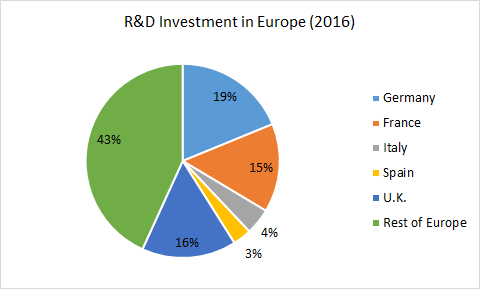The following post comes from Austin Shaffer, a 2L at Scalia Law and a Research Assistant at CPIP.
 By Austin Shaffer
By Austin Shaffer
This past fall, the Department of Justice (DOJ) and U.S. Patent and Trademark Office (USPTO) hosted day two of their public workshop to discuss the importance of intellectual property rights and pro-competitive collaborations for life sciences companies, research institutions, and American consumers. While day one focused on how patents and copyrights impact collaboration and innovation for business development in life science technologies, day two concentrated on competition, collaboration, and licensing, and how those tools can promote access to therapeutics, diagnostics, and vaccines. Video of day two of the workshop is available here, and our summary of day one is available here.
Welcome Remarks, Fireside Chat, and Program Overview
Makan Delrahim, Assistant Attorney General for the DOJ Antitrust Division, kicked off day two with some opening remarks, emphasizing the significant role that IP and antitrust play to encourage innovation and healthy competition as entities around the globe race to find a COVID vaccine.
Mr. Delrahim was then joined by USPTO Director Andrei Iancu for a fireside chat, moderated by Judge Kathleen O’Malley of the U.S. Court of Appeals for the Federal Circuit. Mr. Iancu spoke to the critical pro-competitive role of patents at this time, as they incentivize innovation and disclosure and create transferrable financial instruments. Indeed, obtaining a patent boosts viability and employment growth, particularly for small companies. Additionally, Mr. Iancu highlighted some of the measures that the USPTO is taking to foster innovation and collaboration in the life science sector. One such measure, the Patents 4 Partnerships program, provides the public with a user-friendly, searchable repository of patents and published applications related to the COVID pandemic that are available for licensing. Additionally, the USPTO has extended deadlines and discounted application fees pursuant to the CARES Act.
Following the fireside chat, David Lawrence, Chief, Competition Policy & Advocacy Section at the DOJ, gave a brief overview of the day’s program. Mr. Lawrence noted that the life science sector relies on both competition and collaboration—the key question throughout the upcoming panels is where to draw the line at the cross-section of those factors to promote efficiency and effectiveness.
Session V: Collaboration and Licensing Strategies
Partnerships can serve as a key tool in the development of therapeutics and vaccines from initial research, through product development and clinical trials, and into the market-ready stage. These partnerships and various licensing strategies are particularly relevant to addressing the current pandemic. This panel focused on public-private partnerships, private partnerships, exclusive versus non-exclusive licensing, ownership rights, and information pooling.
The panel included Laura Coruzzi of Regenxbio, Lauren Foster from MIT, Prof. Sheridan Miyamoto from Penn State University, Mita Mukherjee of Emergent BioSolutions, Mark Rohrbaugh of the NIH, and Dick Wilder of the Coalition for Epidemic Preparedness Innovations, and it was moderated by DOJ Deputy Associate Attorney General Brian Pandya.
Each panelist took a turn discussing the role of collaboration in the development of therapeutics and vaccines. Ms. Coruzzi said that while collaboration is important throughout product development, it is particularly critical in the early research stage. Gene therapy research is precariously risky, and investors tend to stay away from those endeavors. Collaboration between multiple entities leads to a higher success rate, thereby providing a greater incentive for investors to get on board. Ms. Mukherjee explained that while big pharma has the expertise in researching and developing a marketable product, the initial work is often more appropriate for smaller, niche companies.
Ms. Foster explained that at MIT, the mission is to make technology broadly available, and by prudently engaging in a collaborative relationship, they can better ensure advancement. While the NIH approaches licensing in a similar manner to MIT, Mr. Rohrbaugh noted some of the statutory requirements and regulations that govern the NIH’s ability to license, such as the requirement to post on the Federal Register for comment. Mr. Wilder argued that the key to successful collaboration is to manage projects on a collective basis to ensuring that the resulting IP is used properly.
Turning to recent developments in licensing structures, Mr. Pandya noted the recent increase in invalidation of IP rights and posed the question: How has this negatively impacted licensing? Ms. Coruzzi cited Mayo v. Prometheus, a 2012 Supreme Court case which held that a natural phenomenon must be sufficiently added upon or transformed in order to make an idea, formula, mechanism, or test patentable. That decision, she argued, has squandered tax-funded university research and placed the U.S. at a competitive disadvantage with other countries that protect purified or engineered natural products. She called on the legislature to fix a decision that “knocked the legs out of patents.”
Session VI: How do Regulation and Antitrust Enforcement Impact Competition and Incentives for Innovation?
The extent to which regulation and antitrust enforcement are necessary to maintain competition is a contested issue, and the answer can have a significant impact on the incentives for innovation. The panelists in this session considered the tradeoffs between the two and the resulting consequences, especially within the context of a pandemic.
The panel included Alden Abbott of the FTC, Prof. Ernst Berndt from MIT, David Kappos of Cravath, Swaine & Moore, Prof. William Kovacic from George Washington University Law School, and Dick Wilder of the Coalition for Epidemic Preparedness Innovations, and it was moderated by Deputy Assistant Attorney General Alexander Okuliar.
Mr. Kappos argued that the patent system has been disabled and marginalized in its role of incentivizing innovation and bringing ideas from the university level to the marketplace for a variety of reasons. Mentioning a host of companies that agree, Mr. Kappos deemed the patent system broken, calling on congressional reform of 35 U.S.C. § 101. From his observations, our restricted statutory scheme has caused investment to flee elsewhere, recent Supreme Court decisions have resulted in decreased overall investment, and venture capital funding is decreasing in patent-reliant sectors.
Pertinent to regulation and antitrust enforcement concerns, several of the panelists pointed to the March 2020 FTC-DOJ Joint Statement as a positive step forward. The statement outlined ways that firms, including competitors, can engage in collaboration for the purpose of public health and safety protection without violating the antitrust laws. Mr. Kovacic called on further FTC and DOJ action, explicating that those agencies have the capacity to analyze the effects of previous policymaking on the life science sector that can provide useful guidance moving forward.
Session VII: Competition and Collaboration: Examining Competitive Effects and Antitrust Risks Associated with Collaborations
In this session, the panelists discussed what makes a collaboration or partnership successful and procompetitive, antitrust concerns that can arise, and potential safeguards that can reduce antitrust risk.
The panel included William Diaz of Amgen, Andrew Finch of Paul Weiss, Prof. Luba Greenwood from Harvard University, and Chuck Loughlin of Hogan Lovells, and it was moderated by the DOJ’s Jennifer Dixton, Special Counsel for Policy & Intellectual Property, Antitrust Division.
Mr. Finch started off the penultimate panel by identifying the hallmarks of a successful joint venture: mechanisms that enable participants in the venture to increase output, clear boundaries as to the scope of the venture, and safeguards to make sure the venture stays “on the rails.” He proposed a “red-yellow-green” system that lawyers can articulate to business clients to let them know what can and cannot be shared, and when to seek advice from counsel for further guidance. Mr. Diaz echoed those sentiments, adding that ventures need a clear charter from the onset of the relationship that provides comprehensive plans for what to do in a variety of scenarios. Also, he continued, it is imperative to keep detailed meeting agendas to avoid members straying into discussions that might raise antitrust concerns.
The panelists went on to commend the usefulness of the DOJ’s Business Review Letters, which provide unusually expedited advisory guidance to firms wondering whether their collaborations will pass antitrust muster. Ms. Dixton, fielding those comments as moderator and in her capacity at the DOJ, then posed a final question to the panel: What else could the Department be doing? The panelists called for updates to the FTC-DOJ Antitrust Guidelines for Collaborations Among Competitors. While still useful, the Guidelines have not been updated in twenty years, leaving many gray areas in today’s world.
Keynote Speech
The keynote speech was delivered by Dr. Elias Zerhouni, Emeritus Professor of Radiology and Biomedical Engineering and Senior Advisor at Johns Hopkins Medicine.
Dr. Zerhouni shared his wealth of life science knowledge and experience in the day’s keynote speech. He made a key point when it comes to the need for collaboration to combat COVID: no single university, single company, or even single country is able to address modern biological issues by themselves—the amount of data generated in the life science sector is simply beyond the capabilities of one player.
Dr. Zerhouni agreed with some of the previous panelists that developments in the patent system have changed the structure of innovation and created a difficult market to negotiate in. He argued for statutory reform that will allow US innovators to pool their IP together to operate more effectively. Although there are many contributing factors to the current state of the patent system, Dr. Zerhouni referred to the Federal Circuit’s 2002 decision in Madey v. Duke University as an inhibitor to pre-competitive innovation. (Madey held that the experimental use defense applied only to acts taken for amusement, to satisfy curiosity, or for strictly philosophical inquiry).
Session VIII: Academics’ and Economists’ Views on Collaboration and Competition
The final panel featured the perspectives of experts from academia and the field of economics, including Prof. Rena Conti from Boston University, Prof. Scott Hemphill from NYU School of Law, Richard Manning of Bates White Economic Consulting, and Prof. Joanna Shepherd from Emory Law School, and it was moderated by Patrick Greenlee, Economist with the DOJ’s Antitrust Division.
Mr. Greenlee asked one question of the final panel: Are the current prices for life sector IP too high? That question fielded diverse opinions and evaluations. Mr. Manning said there is no cause for worry because the profit margins “aren’t that big.” Prof. Shepherd agreed, citing historically low lifetime revenues for new drugs, resulting in decreasing returns on R&D for pharmaceutical companies. Prof. Hemphill took a step back, arguing that our economic knowledge is still too limited to know the optimal level for the collaboration-competition tradeoff. Prof. Conti contended that we may be looking at the system entirely wrong—when evaluating mergers and the value of IP assets, the value of labor and manufacturing assets and access to raw materials is often overlooked.
Conclusion
Overall, the second day of the DOJ-USPTO workshop on promoting innovation in the life science sector left us with a lot to consider in the coming months as COVID vaccinations continue to be developed and distributed. What is the optimal level of antitrust enforcement? How can firms effectively, and legally, take advantage of licensing strategies and collaboration to expedite development? Does our patent system need to be reformed in the wake of the pandemic? These are questions of the upmost importance for our industry leaders and policymakers to consider and solve.
 By Colin Kreutzer
By Colin Kreutzer CPIP has published a new policy brief by Joanna M. Shepherd, Vice Dean and Thomas Simmons Professor of Law at Emory University School of Law. The brief, entitled
CPIP has published a new policy brief by Joanna M. Shepherd, Vice Dean and Thomas Simmons Professor of Law at Emory University School of Law. The brief, entitled  By Yumi Oda
By Yumi Oda On December 21, 2018, CPIP Senior Scholars Adam Mossoff and Kristen Osenga joined former Federal Circuit Chief Judge Randall Rader and SIU Law’s Mark Schultz in
On December 21, 2018, CPIP Senior Scholars Adam Mossoff and Kristen Osenga joined former Federal Circuit Chief Judge Randall Rader and SIU Law’s Mark Schultz in  While recent headlines claim that rising drug prices can be easily addressed through government intervention, the procedures involved with government use of patented technologies are complex and often misunderstood. In addition to owning and practicing a vast portfolio of patents, the government has the power to procure and use patented technologies—including pharmaceutical medicines—in limited circumstances without specific authorization, license, or consent. But despite established mechanisms for government use of intellectual property, some advocates are now promoting an unprecedented and expansive interpretation of procurement that would deprive patent owners of their rights and threaten pharmaceutical innovation.
While recent headlines claim that rising drug prices can be easily addressed through government intervention, the procedures involved with government use of patented technologies are complex and often misunderstood. In addition to owning and practicing a vast portfolio of patents, the government has the power to procure and use patented technologies—including pharmaceutical medicines—in limited circumstances without specific authorization, license, or consent. But despite established mechanisms for government use of intellectual property, some advocates are now promoting an unprecedented and expansive interpretation of procurement that would deprive patent owners of their rights and threaten pharmaceutical innovation. Innovation is all around us. We love and appreciate the latest video games, software apps, and smartphones. We await the integration of self-driving cars and other forms of artificial intelligence. Beyond the gadgets and luxuries we think we can’t live without, there are even more essential products that affect the lives of millions around the world on a daily basis. Patented medicines are at the top of the list of innovations that save lives and preserve the quality of life. Unfortunately, some proposed changes to European patent law are jeopardizing the development and delivery of safe and effective drugs, threatening jobs and innovation, and putting global public health at risk.
Innovation is all around us. We love and appreciate the latest video games, software apps, and smartphones. We await the integration of self-driving cars and other forms of artificial intelligence. Beyond the gadgets and luxuries we think we can’t live without, there are even more essential products that affect the lives of millions around the world on a daily basis. Patented medicines are at the top of the list of innovations that save lives and preserve the quality of life. Unfortunately, some proposed changes to European patent law are jeopardizing the development and delivery of safe and effective drugs, threatening jobs and innovation, and putting global public health at risk.
 CPIP has published a new policy brief entitled
CPIP has published a new policy brief entitled